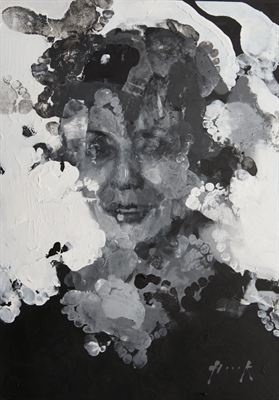HILLSBOROUGH TRIBUTES

New objects join Museum of Liverpool’s collection
Two new items join the Museum of Liverpool’s collection, to go on public display on 5 April 2016, marking the anniversary of the 1989 Hillsborough tragedy (15 April).
The items - a painting of actress Sue Johnston and a patchwork quilt - have a common source of inspiration; the resilience of the families of the 96 people who lost their lives during the FA Cup semi-final between Liverpool and Nottingham Forest.
You are invited to a press preview at the Museum of Liverpool on 5 April at 1pm.
Available for interview and photographs: actress, Sue Johnston, Hillsborough campaigner, Margaret Aspinall, artist Christian Hook, quilt-maker Linda Whitfield and Paul Gallagher, Acting Senior Curator of Urban History.
The painting is a remarkable portrait of actress Sue Johnston by international award-winning artist, Christian Hook. Moved by Sue’s campaign work with the Hillsborough Family Support Group (HFSG), Christian first created a conventional black and white portrait of Sue. He then completed the painting using his feet while listening to the Liverpool anthem, You’ll Never Walk Alone. The song’s emotive chorus takes on a new meaning in the context of the Hillsborough tragedy, something powerfully expressed through Christian’s work.
Christian Hook said: “I am extremely honoured to be a part of today and very proud to have Sue's portrait hung in the prestigious Museum of Liverpool, supporting a truly inspirational support group for the anniversary of the Hillsborough tragedy.”
The patchwork quilt was made from donated football shirts and skilfully crafted by Merseyside woman, Linda Whitfield. 96 Liver Birds make up the quilt and represent the lives lost, with the children poignantly remembered by a smaller Liver Bird from a child's shirt. The quilt also includes each of the victims’ names, with those who went to the match together kept close together on the quilt.
Linda Whitfield said: “In the summer of 2014 I watched the news on the families’ fight for justice on TV and it gave me inspiration for my next project. With the help from a large number of Liverpool fans my vision came to life.
“I was fortunate enough not to lose anyone in the disaster but being part of a big LFC family it has an important place in my heart.”
Janet Dugdale, Director of the Museum of Liverpool said: “We are proud to display two unique tributes that commemorate both the lives lost at Hillsborough, as well as the incredible fortitude of the families in their campaign.
“From a painting of a much-loved celebrity by an internationally-recognised artist to a local woman’s lovingly created quilt, made with donations from the community, the two objects demonstrate the admiration the Hillsborough families have gained for their determination and commitment.”
The Museum will also display the number ‘96’ in 3 metres high red and white lettering near the front entrance to the building. The Museum of Liverpool is dedicated to telling the story of the city and its people, and the ‘96’ will be on display from 5 April to 18 April 2016 to include the anniversary of the tragedy (15 April), as a symbol of the city’s united grief for those who were lost but will never be forgotten.
Ends
Free entry
Open daily 10am-5pm
Address
www.liverpoolmuseums.org.uk/mol
Telephone 0151 478 4545
@MuseumLiverpool
Facebook/museumofliverpool
Notes to editors:
Museum of Liverpool
The Museum of Liverpool is one of the country’s most visited museums outside of London. It is the largest newly-built national museum in Britain for more than a century, demonstrating Liverpool’s unique contribution to the world. The first national museum devoted to the history of a regional city, it showcases popular culture while tackling social, historical and contemporary issues. It has attracted more than two million visitors since opening in July 2011. The prestigious Council of Europe Museum Prize for 2013 was awarded to the Museum for its commitment to human rights as well as its work with children and families from all backgrounds.
The Museum has received generous support from several major funders, and grants from trusts and foundations, corporate support and individual donations. Major funders include the Northwest Regional Development Agency (NWDA), The European Regional Development Fund (ERDF), the Heritage Lottery Fund (HLF), the Department for Culture Media and Sport (DCMS),Garfield Weston Foundation and the Clore Duffield Foundation.
The Northwest Regional Development Agency (NWDA) was responsible for the sustainable economic development and regeneration of England’s Northwest and had five key priorities: Business, Skills and Education, People and Jobs, Infrastructure and Quality of Life.
The European Development Fund (ERDF) is making a real difference to people and businesses in the North West. With €755 million to invest between 2007 and 2013, ERDF is enhancing the competitiveness of the region’s economy by supporting growth in enterprise and employment. ERDF in the North West is managed by the Department for Communities and Local Government – for further information visit www.communities.gov.uk/erdf.
Using money raised through the National Lottery, the Heritage Lottery Fund (HLF) sustains and transforms a wide range of heritage for present and future generations to take part in, learn from and enjoy. From museums, parks and historic places to archaeology, natural environment and cultural traditions, we invest in every part of our diverse heritage. HLF has supported more than 30,000 projects allocating £4.5billion across the UK.
About National Museums Liverpool
National Museums Liverpool comprises eight venues, including some of the most visited museums in England outside of London. Our collections are among the most important and varied in Europe and contain everything from Impressionist paintings and rare beetles to a lifejacket from the Titanic. We attract nearly 2.7 million visitors every year. Our venues are the Museum of Liverpool, World Museum, the Walker Art Gallery, Merseyside Maritime Museum, International Slavery Museum, Border Force National Museum, Sudley House and the Lady Lever Art Gallery.


